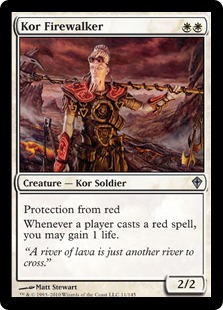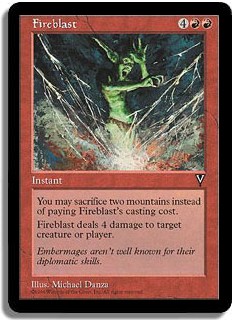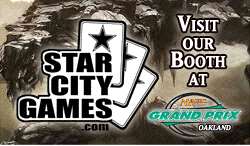I’m already at that place one doesn’t want to be. I’m gnashing teeth and rending garments. All because of a little bastard of a card called Kor Firewalker.

God, this guy might as well be another Kyle Rose for me. For those of you who don’t remember the former U.S. National Champion and Pro Tour: London (1999) Champion, Kyle Rose is one of those people that just has my number. The more local equivalent for me might be Chicago-area player Mike Bernat; these guys just seem to have a history of beating me.
I wouldn’t be surprised if Kyle didn’t remember the times that he’s beaten me, but I definitely do. I particularly remember a match in Grand Prix: Detroit where he took me down in two games. My deck was fantastic, and I played great, but he just kept seeming to have an endless supply of gas. At one point, we’re both completely out of action, on the board, and I’m waiting on a mana for what seems like the entire game so I can finally drop my Crosis, the Purger that has been rotting in my hand. He casts and kicks a Thicket Elemental off of the top of his deck and reveals another monster so that now, even if I draw a land for Crosis, I’m still dead. Most games I’ve had with Kyle seem to go this way, with Kyle always having an upper hand that in the end makes me heave a frustrated sigh.
That frustrated sigh is the one I’m expecting to be sighing over Kor Firewalker.
I’ve played Red decks of various stripes for years. I remember having a conversation about Red with Ronnie Serio (of former Magic mega-team The Crew) about Red. Back in the day, I would always mock Red decks as being inelegant and stupid. A part of me, I think, was in love with the Sligh decks of old; these decks were actual card advantage engine decks, even if they didn’t look like it to most people. I liked Sligh. The Ball Lightning/Fireblast decks that were upstarts a million years ago just made me mad.



“Oh, you cast Wrath of God? Take 13.”
This used to make me shudder. Now I mostly sort of love it.
I think the big thing that shifted for me was watching some of the true masters of Red play their decks. Dave Price was one of these people. The People’s Champion. The King of the Qualifiers. Pro Tour: Los Angeles Champion. Dave Price was the kind of guy that made you want to play Magic. Before Mike Flores and I edited The Dojo, Dave Price was their with his hands on the reigns. But before people really knew much about Dave Price, what they were likely to know about him was that he tended to play Red decks. Check out these two:
Tempest Price Red — 1st, Pro Tour: Los Angeles
4 Jackal Pup
4 Mogg Conscripts
4 Mogg Fanatic
4 Mogg Raider
4 Canyon Wildcat
4 Fireslinger
2 Rathi Dragon
4 Giant Strength
4 Cursed Scroll
4 Kindle
2 Scalding Tongs
The man ran Giant Strength to win Pro Tour: Los Angeles. Awesome. Simply awesome.
He had a similarly brilliant deck for U.S. Nationals, back when it was widely considered the most difficult Standard tournament in the world.
Deadguy Red — 1997 U.S. Nationals 6-0
4 Goblin Vandals
3 Goblin Digging Team
4 Ironclaw Orcs
2 Dwarven Soldier
4 Ball Lightning
2 Viashino Sandstalkers
4 Lava Hounds
4 Incinerate
4 Hammer of Bogardan
4 Fireblast
3 Kaervak’s Torch
4 Dwarven Ruins
18 Mountain
This deck was the beginning of the decks that would drive me crazy. I was always far more interested in Sligh: versatile creatures, mana curve, ability to gain card advantage. This deck was just going to kill the opponent, and it was incredibly effective at doing it. Particularly impressive were the Lava Hounds, which were a nod to the fact that most people simply couldn’t even begin to put out the kind of damage that this deck could, so the loss of life wasn’t scary at all.
In the Midwest tournament scene, decks of this ilk started dominating even more than they were in other areas of the world. Bolt may have rotated, but they still had Incinerate and Fireblast. Some of my friends and I took to calling the Ball Lighting/Fireblast decks “Blitz” to contrast them with the “honest” Sligh deck. Few joined us. Chicago players in particular, seems to love Red in this era, a trend that continues to today. Dave Peterson and Ronny Serio were two of the players that seemed most likely to go this route, and so I got to see the deck again and again and again.
Playing to beat Red was my M.O. for a long, long time. It really wasn’t until Brian Kowal designed the first Ponza deck that I started actually liking playing Red myself, perhaps because his deck was far closer to the Sligh deck that I really had loved.
As I dived into testing Ponza decks, I started noticing something: all of the time, Ponza could get an opponent to one life. Usually, when you unraveled the game, you’d notice that there was some small play that might have made all of the difference.
I started rethinking all of my long years of testing against “Blitz” decks, and thought back to all of the times that Dave Peterson ever-so-barely beat my deck that was “supposed” to beat Red. Dave would consistently just barely get me. It was never a blowout, but my deck that I’d honed to be very good against Red would flip in results when he was at the helm of Red.
This brought me to what I’m going to call “The Red Maxim.”
If you’ve brought your opponent to one life and you lose the game, you probably made a mistake.
Now, this isn’t always true. But it usually is. Sometimes it can be something as subtle as convincing your opponent via signals that they ought to attack or not attack. Sometimes it can be a decision about casting a Ball Lightning over a Hell’s Thunder on turn 3 (or vice versa). Even when it isn’t true, keeping the Red Maxim in mind is useful when you’re thinking about your plays. You have to always be looking for a way to win, or you’ll hit situations where you simply won’t find it. This is true of all decks, but with Red, the margins are often so slim, it becomes particularly important.
I was recently playing one match with the deck I favor in Standard Right now:
Creatures (22)
- 4 Ball Lightning
- 4 Hell's Thunder
- 4 Hellspark Elemental
- 4 Goblin Guide
- 2 Obsidian Fireheart
- 4 Plated Geopede
Lands (25)
Spells (13)

At one point, my opponent had out 3 Dragon’s Claw and 2 Howling Mines, and was at a fairly high life total, near 20. It was game 3, so conceding wasn’t an option. Finding the path to victory was a puzzle, but I just barely managed to get it to happen… exactly to the life point.
If they had been Kor Firewalkers, though, I would have been destroyed.
Dragon’s Claw is fundamentally different than Kor Firewalker in one crazy important way: it doesn’t interact with the board. Kor Firewalker can not only attack, but it can block, and that simple fact changes everything.
Of course, just because Kor Firewalker is good doesn’t mean that it is good enough to see play in main decks. It is resistant to Lightning, to Terminate, to Quake, to Ajani Vengeant, to Sprouting Thrinax, and to Bloodbraid Elf. This means that it has a lot of value against a whole slew of decks that exist in the now, but there is no telling whether these decks are going to exist in the metagame of tomorrow.
So, what is a poor, hapless, teeth-gnashing, garment-rending Red player to do about this card if they don’t want to dip into another color? The options are fairly few.
Valakut, the Molten Pinnacle — Probably only a reliable option for heavily controlling decks, Valakut really does deal with the problem if you can get to the seven lands it demands of you. Of course, by turn 7, they might have gotten in 10 damage with their Firewalker.
Filling the board — This option is fairly dangerous. If you can put enough on the board that a Kor Firewalker wants to sit at home, and you’re still getting in the damage over the top of it, this is a great option. Some creatures (Obsidian Fireheart comes to mind) are really good at this. Unfortunately, it is a great way to set yourself up for Day of Judgment or Earthquake, and a second Kor Firewalker often makes this plan go all to hell.
Quicksand — If nothing else, you can at least hold it off with a Quicksand. Sure, you’re still going to be dealing with two terrible effects, but at least you can hold off the thing from actually attacking you, and Quicksand is also a solid card choice against another opponent.
Gargoyle Castle and Dread Statuary — Here is the opposite plan from Quicksand; turn your extra land into a critter that could take the Firewalker out, and have it double as a kill condition. Unfortunately, this plan does have the Valakut problem; it could simply end up coming way to late. Further, Path to Exile suddenly explodes in value.
Smoldering Spires — With the right timing, Smoldering Spires, particularly in multiples, could really help you get to the level of damage you’d need to overcome a Kor Firewalker. Of course, they already need to be in a tenuous position, usually, for this to work out, and it doesn’t solve the problem of racing.
Unstable Footing — Now this is getting somewhere. Running Unstable Footing main is probably not an option, but Unstable Footing can create ways to kill Kor Firewalkers. Particularly if you’ve cast a Ball Lightning, often a pair of Protection creatures might hop in the way to sop up the damage. If you drop an Unstable Footing in there, even unkicked, even if you haven’t netted any damage, at least you’ve killed their Firewalkers.
Blazing Torch — It will do the work you need it to do, but it certainly has some major limitations. It is slow and unwieldy, for one. It doesn’t push through on a Firewalker that has been pumped by any effect. Still, this might just be the go-to card for those decks that are running enough creatures to not be too hamstrung by relying on an equipment.
Stone Idol Trap — This might be the ideal solution, if you think that your opponent is going to potentially attack into it. As a colorless creature token, the Stone Idol Trap will be able to take down a Kor Firewalker, but usually no sooner than turn 5 (or occasionally slightly earlier). In addition, it takes back some of that life gain that a Firewalker will have built up. Unfortunately, it is still weak to Path to Exile-style answers. On the plus side, though, it is a card that might actually have use against other decks as well.
There are other, more convoluted ways to accomplish the task. Playing a Platinum Angel, for example, could largely take care of the problem, at least for a little bit, but we have to remember that we’re still attempting to play a deck that is accomplishing something. It’s all fine and dandy to stretch your deck really hard, but if all you end up doing is succumbing to The Fear in your deckbuilding, you aren’t doing yourself any favors.
I’ve been really enjoying playing my Red deck as a way to get discount packs online. I know that things are about to get much harder for me if I want to keep at it, but there are options once Worldwake comes in. If someone is really hungry to beat Red, they probably will. The goal is to beat the people that also want to beat someone else.
And that is something that you can do.
Until next week…

